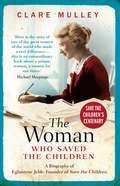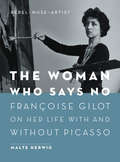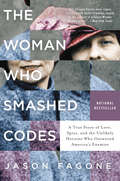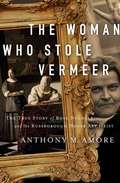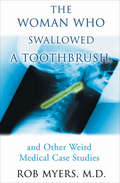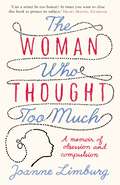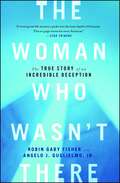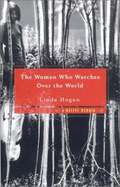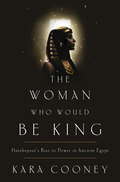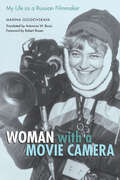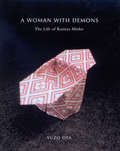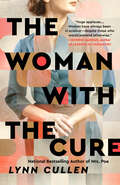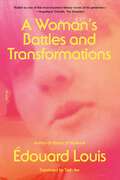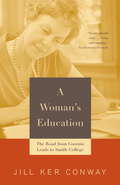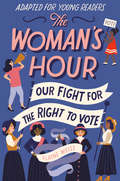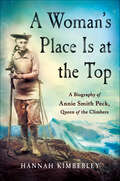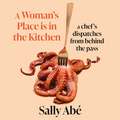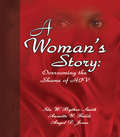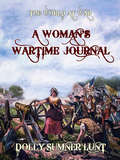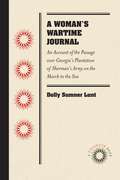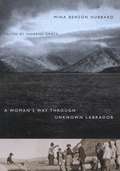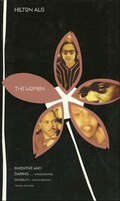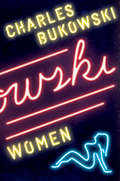- Table View
- List View
The Woman Who Saved the Children: A Biography of Eglantyne Jebb: Founder of Save the Children
by Clare MulleySince 1919 Save the Children has fought to uphold the human rights of children worldwide. Now promoted by the likes of Brad Pitt, George Clooney, and Julianne Moore the charity's founder was a childless spinster whose most famous line, 'I don't care for children' makes hers a most unconventional story. Eglantyne's short life was full of passion and pain, moving from illicit romance in Cambridge to espionage in Serbia. Her achievements in putting children's universal human rights on the world agenda are a powerful testament to her eccentric charisma and humane vision. Clare Mulley joined Save the Children as a corporate fundraiser in the 1990s. Mother of three daughters, she currently lives in Essex, UK.
The Woman Who Says No: Françoise Gilot on Her Life With and Without Picasso - Rebel, Muse, Artist
by Malte HerwigPablo Picasso called Françoise Gilot "The Woman Who Says No." Tiny, talented, and feisty, and an accomplished artist in her own right, Gilot left Picasso after a ten-year relationship, the only woman to escape his intense attentions unscathed. From 2012 to 2014, German journalist and author Malte Herwig dropped by her ateliers in Paris and New York to chat with her about life, love, and art. She shared trenchant observations, her sharp sense of humor, and over ninety years of experience, much of it in the company of men who changed the world: Picasso, Matisse, and her second husband, the famous virologist Jonas Salk, developer of the polio vaccine. Never one to stand in the shadows, Gilot engaged with ground-breaking artists and scientists on her own terms, creating from these vital interactions an artistic style all her own, translated into an enormous collection of paintings and drawings held by private collectors and public museums around the world. In her early nineties, she generously shared her hospitality and wisdom with Herwig, who started out as an interviewer but found himself drawn into the role of pupil as Gilot, whom he called "a philosopher of joy," shared with him different ways of seeing the world.
The Woman Who Smashed Codes: A True Story of Love, Spies, and the Unlikely Heroine Who Outwitted America's Enemies
by Jason FagoneJoining the ranks of Hidden Figures and In the Garden of Beasts, the incredible true story of the greatest codebreaking duo that ever lived, an American woman and her husband who invented the modern science of cryptology together and used it to confront the evils of their time, solving puzzles that unmasked Nazi spies and helped win World War II.In 1916, at the height of World War I, brilliant Shakespeare expert Elizebeth Smith went to work for an eccentric tycoon on his estate outside Chicago. The tycoon had close ties to the U.S. government, and he soon asked Elizebeth to apply her language skills to an exciting new venture: code-breaking. There she met the man who would become her husband, groundbreaking cryptologist William Friedman. Though she and Friedman are in many ways the "Adam and Eve" of the NSA, Elizebeth’s story, incredibly, has never been told.In The Woman Who Smashed Codes, Jason Fagone chronicles the life of this extraordinary woman, who played an integral role in our nation’s history for forty years. After World War I, Smith used her talents to catch gangsters and smugglers during Prohibition, then accepted a covert mission to discover and expose Nazi spy rings that were spreading like wildfire across South America, advancing ever closer to the United States. As World War II raged, Elizebeth fought a highly classified battle of wits against Hitler’s Reich, cracking multiple versions of the Enigma machine used by German spies. Meanwhile, inside an Army vault in Washington, William worked furiously to break Purple, the Japanese version of Enigma—and eventually succeeded, at a terrible cost to his personal life.Fagone unveils America’s code-breaking history through the prism of Smith’s life, bringing into focus the unforgettable events and colorful personalities that would help shape modern intelligence. Blending the lively pace and compelling detail that are the hallmarks of Erik Larson’s bestsellers with the atmosphere and intensity of The Imitation Game, The Woman Who Smashed Codes is page-turning popular history at its finest.
The Woman Who Stole Vermeer: The True Story of Rose Dugdale and the Russborough House Art Heist
by Anthony M. AmoreThe extraordinary life and crimes of heiress-turned-revolutionary Rose Dugdale, who in 1974 became the only woman to pull off a major art heist.In the world of crime, there exists an unusual commonality between those who steal art and those who repeatedly kill: they are almost exclusively male. But, as with all things, there is always an outlier—someone who bucks the trend, defying the reliable profiles and leaving investigators and researchers scratching their heads. In the history of major art heists, that outlier is Rose Dugdale. Dugdale&’s life is singularly notorious. Born into extreme wealth, she abandoned her life as an Oxford-trained PhD and heiress to join the cause of Irish Republicanism. While on the surface she appears to be the British version of Patricia Hearst, she is anything but. Dugdale ran head-first towards the action, spearheading the first aerial terrorist attack in British history and pulling off the biggest art theft of her time. In 1974, she led a gang into the opulent Russborough House in Ireland and made off with millions in prized paintings, including works by Goya, Gainsborough, and Rubens, as well as Lady Writing a Letter with her Maid by the mysterious master Johannes Vermeer. Dugdale thus became—to this day—the only woman to pull off a major art heist. And as Anthony Amore explores in The Woman Who Stole Vermeer, it&’s likely that this was not her only such heist. The Woman Who Stole Vermeer is Rose Dugdale&’s story, from her idyllic upbringing in Devonshire and her presentation to Elizabeth II as a debutante to her university years and her eventual radical lifestyle. Her life of crime and activism is at turns unbelievable and awe-inspiring, and sure to engross readers.
The Woman Who Swallowed a Toothbrush: And Other Bizarre Medical Cases
by Robert MyersDrawing from real medical journal cases, a doctor shares true stories about strange symptoms and perplexing patients. Those in the medical profession know that sometimes the cases that come into emergency rooms or doctor’s offices can be highly unusual—and depending on how things go, the results can be either tragic or comic. This collection of stories reveals some of the oddest and most memorable case histories, from the woman who claims she was brushing her teeth when she swallowed her toothbrush—but in fact was a bulimic using it to induce vomiting—to the man whose routine elective back surgery revealed he’d been carrying a bullet around in his body for years. From the funny to the frightening, these documented memorable medical mysteries make for fascinating reading.
The Woman Who Thought too Much: A Memoir
by Joanne LimburgFor readers of A Year of Magical Thinking by Joan Didion and Bad Blood by Lorna Sage comes an intensely honest and surprisingly witty literary memoir of one woman's life as a sufferer of Obsessive-compulsive disorder Joanne Limburg is a woman who thinks things she doesn't want to think, and who does things she doesn't want to do. As a small child, she would chew her hair all day and lie awake at night wondering if heaven had a ceiling; a few years later, when she should have been doing her homework, she was pacing her bedroom, agonizing about the unfairness of life as a woman, and the shortness of her legs. By the time she was an adult, obsessive thoughts and compulsive behaviors had come to dominate her life. She knew that something was wrong with her, but it would take many years before she understood what that something was. This memoir follows Limburg's quest to understand her OCD and to manage her symptoms, taking the reader on a journey through consulting rooms, libraries, and websites as she learns about rumination, scrupulosity, avoidance, thought-action fusion, fixed-action patterns, anal fixations, schemas, basal ganglia, tics, and synapses. Meanwhile, she does her best to come to terms with an illness that turns out to be common and even—sometimes—treatable. This vividly honest memoir is a sometimes shocking, often humorous revelation of what it is like to live with so debilitating a condition. It is also an exploration of the inner world of a poet and an intense evocation of the persistence and courage of the human spirit in the face of mental illness.
The Woman Who Wasn't There: The True Story of an Incredible Deception
by Robin Gaby Fisher Angelo J. Guglielmo Jr.It was a tale of loss and recovery, of courage and sorrow, of horror and inspiration. Tania Head’s astonishing account of her experience on September 11, 2001—from crawling through the carnage and chaos to escaping the seventy-eighth-floor sky lobby of the burning south tower to losing her fiancé in the collapsed north tower—transformed her into one of the great victims and heroes of that tragic day. Tania selflessly took on the responsibility of giving a voice and a direction to the burgeoning World Trade Center Survivors’ Network, helping save the “Survivor Stairway” and leading tours at Ground Zero, including taking then-governor Pataki, Mayor Bloomberg, and former mayor Giuliani on the inaugural tour of the WTC site. She even used her own assets to fund charitable events to help survivors heal. But there was something very wrong with Tania’s story—a terrible secret that would break the hearts and challenge the faith of all those she claimed to champion. Told with the unique insider perspective and authority of Angelo J. Guglielmo, Jr., a filmmaker shooting a documentary on the efforts of the Survivors’ Network, and previously one of Tania’s closest friends, The Woman Who Wasn’t There is the story of one of the most audacious and bewildering quests for acclaim in recent memory—one that poses fascinating questions about the essence of morality and the human need for connection at any cost.
The Woman Who Watches Over the World: A Native Memoir
by Linda HoganHogan, a poet, novelist, essayist, and author of ten previous books, recounts the development of her American-Indian identity, her difficult childhood as the daughter of an army sergeant, her love affair at the age of 12 with an older man, and the troubled history of the two daughters she adopted. Revealing how historic and emotional pain are passed down through generations, she blends personal history with stories of important Indian figures of the past such as Lozen, the woman who was the military strategist for Geronimo, and Ohiyesha, the medical doctor who witnessed the massacre at Wounded Knee.
The Woman Who Would Be King: Hatshepsut's Rise to Power in Ancient Egypt
by Kara CooneyAn engrossing biography of the longest-reigning female pharaoh in Ancient Egypt and the story of her audacious rise to power. Hatshepsut--the daughter of a general who usurped Egypt's throne and a mother with ties to the previous dynasty--was born into a privileged position in the royal household, and she was expected to bear the sons who would legitimize the reign of her father's family. Her failure to produce a male heir was ultimately the twist of fate that paved the way for her improbable rule as a cross-dressing king. At just over twenty, Hatshepsut ascended to the rank of pharaoh in an elaborate coronation ceremony that set the tone for her spectacular reign as co-regent with Thutmose III, the infant king whose mother Hatshepsut out-maneuvered for a seat on the throne. Hatshepsut was a master strategist, cloaking her political power plays in the veil of piety and sexual reinvention. Just as women today face obstacles from a society that equates authority with masculinity, Hatshepsut shrewdly operated the levers of power to emerge as Egypt's second female pharaoh.Hatshepsut successfully negotiated a path from the royal nursery to the very pinnacle of authority, and her reign saw one of Ancient Egypt's most prolific building periods. Scholars have long speculated as to why her monuments were destroyed within a few decades of her death, all but erasing evidence of her unprecedented rule. Constructing a rich narrative history using the artifacts that remain, noted Egyptologist Kara Cooney offers a remarkable interpretation of how Hatshepsut rapidly but methodically consolidated power--and why she fell from public favor just as quickly. The Woman Who Would Be King traces the unconventional life of an almost-forgotten pharaoh and explores our complicated reactions to women in power.From the Hardcover edition.
Woman with a Movie Camera: My Life as a Russian Filmmaker (Constructs Series)
by Marina GoldovskayaMarina Goldovskaya is one of Russia's best-known documentary filmmakers. <P><P>The first woman in Russia (and possibly the world) to combine being a director, writer, cinematographer, and producer, Goldovskaya has made over thirty documentary films and more than one hundred programs for Russian, European, Japanese, and American television. Her work, which includes the award-winning films The House on Arbat Street, The Shattered Mirror, and Solovky Power, has garnered international acclaim and won virtually every prize given for documentary filmmaking.
A Woman with Demons
by Yuzo OtaFew English biographies about Japanese subjects provide such an intimate look into the subject's inner life.
The Woman with the Cure
by Lynn Cullen"Huge applause... women have always been in science—despite those who would pretend otherwise.&” --Bonnie Garmus, New York Times bestselling author of Lessons in ChemistryShe gave up everything — and changed the world. A riveting novel based on the true story of the woman who stopped a pandemic, from the bestselling author of Mrs. Poe. In 1940s and &’50s America, polio is as dreaded as the atomic bomb. No one&’s life is untouched by this disease that kills or paralyzes its victims, particularly children. Outbreaks of the virus across the country regularly put American cities in lockdown. Some of the world&’s best minds are engaged in the race to find a vaccine. The man who succeeds will be a god. But Dorothy Horstmann is not focused on beating her colleagues to the vaccine. She just wants the world to have a cure. Applying the same determination that lifted her from a humble background as the daughter of immigrants, to becoming a doctor –often the only woman in the room--she hunts down the monster where it lurks: in the blood. This discovery of hers, and an error by a competitor, catapults her closest colleague to a lead in the race. When his chance to win comes on a worldwide scale, she is asked to sink or validate his vaccine—and to decide what is forgivable, and how much should be sacrificed, in pursuit of the cure.
A Woman's Battles and Transformations
by Édouard LouisA Woman's Battles and Transformations is a portrait of the author’s mother by the acclaimed writer of the international bestsellers The End of Eddy and History of Violence.Late one night, Édouard Louis got a call from his forty-five-year-old mother: “I did it. I left your father.” Suddenly, she was free.This is the searing and sympathetic story of one woman’s liberation: of mothers and sons, of history and heartbreak, of politics and power. It reckons with the cruel systems that govern our lives—and with the possibility of escape. Sharp, short, and fine as a needle, it is a necessary addition to the work of Édouard Louis, “one of France’s most widely read and internationally successful novelists” (The New York Times Magazine).
A Woman's Education
by Jill Ker ConwayThe acclaimed author of the best-selling The Road from Coorain and True North now gives us the third book in her remarkable continuing memoir--describing the pleasures, the challenges, and the constant surprises (good and bad) of her years as the first woman president of Smith College.The story opens in 1973 as Conway, unbeknownst to her, is first "looked over" as a prospective candidate by members of the Smith community, and continues as she assesses her passions and possibilities and agrees to the new challenge of heading the college in 1975. The jolt of energy she gets from being surrounded by several thousand young women enables her to take on the difficulties that arise in dealing with the diverse Smith constituencies--from the self-appointed protectors of the great male tradition of humanistic learning to the equally determined young feminists insisting on change. We see Conway juggling the needs and concerns of faculty, students, parents, trustees, and alumnae, and re-defining and redesigning aspects of the college to create programs in line with the new realities of women's lives. We sense the urgency of her efforts to shape an institution that will attract students of the 1990s and beyond.Through it all we see Jill Ker Conway coping with her husband's illness, and learning to protect and sustain her inner self. As the end of a decade at Smith approaches, we see her realizing that she has both had her education and made her contributions, and that it is time now for her to graduate.From the Hardcover edition.
The Woman's Hour (Adapted for Young Readers): Our Fight for the Right to Vote
by Elaine WeissThis adaptation of the book Hillary Clinton calls "a page-turning drama and an inspiration" will spark the attention of young readers and teach them about activism, civil rights, and the fight for women's suffrage--just in time for the 100th anniversary of the ratification of the Nineteenth Amendment. Includes an eight-page photo insert!American women are so close to winning the right to vote. They've been fighting for more than seventy years and need approval from just one more state. But suffragists face opposition from every side, including the "Antis"--women who don't want women to have the right to vote. It's more than a fight over politics; it's a debate over the role of women and girls in society, and whether they should be considered equal to men and boys. Over the course of one boiling-hot summer, Nashville becomes a bitter battleground. Both sides are willing to do anything it takes to win, and the suffragists--led by brave activists Carrie Catt, Sue White, and Alice Paul--will face dirty tricks, blackmail, and betrayal. But they vow to fight for what they believe in, no matter the cost.
A Woman's Journey Round the World: From Vienna to Brazil, Chili, Tahiti, China, Hindostan, Persia, and Asia Minor
by Ida PfeifferThis scarce antiquarian book is a facsimile reprint of the original. Due to its age, it may contain imperfections such as marks, notations, marginalia and flawed pages. Because we believe this work is culturally important, we have made it available as part of our commitment for protecting, preserving, and promoting the world's literature in affordable, high quality, modern editions that are true to the original work.
A Woman's Place Is at the Top: A Biography of Annie Smith Peck, Queen of the Climbers
by Hannah KimberleyAnnie Smith Peck is one of the most accomplished women of the twentieth century that you have never heard of. Peck was a scholar, educator, writer, lecturer, mountain climber, suffragist, and political activist. She was a feminist and an independent thinker who refused to let gender stereotypes stand in her way. Peck gained fame in 1895 when she first climbed the Matterhorn at the age of forty-five – not for her daring alpine feat, but because she climbed wearing pants. Fifteen years later, she was the first climber ever to conquer Mount Huascarán (21,831 feet) in Peru. In 1911, just before her sixtieth birthday, she entered a race with Hiram Bingham (the model for Indiana Jones) to climb Mount Coropuna. A Woman’s Place Is at the Top: The Biography of Annie Smith Peck is the first full length work about this incredible woman who single-handedly carved her place on the map of mountain climbing and international relations. Peck marched in suffrage parades and became a political speaker and writer before women had the right to vote. She was a propagandist, an expert on North-South American relations, and an author and lecturer contracted to speak as an authority on multinational industry and commerce before anyone had ever thought to appoint a woman as a diplomat. With unprecedented access to Peck’s original letters, artifacts, and ephemera, Hannah Kimberley brings Peck’s entire life to the page for the first time, giving Peck her rightful place in history.
A Woman's Place is in the Kitchen: dispatches from behind the pass
by Sally Abé'Fantastic, exciting deep dive into kitchen life from one of Britain's leading young chefs' TOM KERRIDGE'Sally really tells it how it is . . . This book will be a go to for those needing that bit of bravery and resilience in a world that needs more people like her' CANDICE BROWN'Wow. Sally's book is an insightful, honest account of a young cook's journey to an inspirational chef' ANGELA HARTNETTFrom the star of the Great British Menu, for readers who loved Kitchen Confidential and couldn't tear their eyes away from Boiling Point, a book that reveals the reality of working in restaurant kitchens - and how they need to change for the betterIt's a familiar trope: angry men berating each other in kitchens as pots furiously boil, sauces burn and a giant slab of beef rests in the background. The dominant view of a professional kitchen is one of chaos and pent-up fury - a gladiatorial contest of male ego. Why then do we also hear the misogynistic refrain that women 'belong in the kitchen' if, in a professional context, they're all but erased from them? A Woman's Place is in the Kitchen is the story of Sally Abé's rise to become an award-winning chef in the brutal world of restaurant kitchens; how a girl from the midlands who used to cook herself Smash to get by is now one of the most successful fine-dining chefs working today. More than that, Sally's story is also a stirring manifesto - drawing back the curtain on restaurant kitchens to show how she is endeavouring to change them for the better. Filled with stories of Michelin-starred food, the relentlessness of kitchens, as well as the hope for the future of the culinary landscape, Sally's memoir is set to become a classic.
A Woman's Place is in the Kitchen: dispatches from behind the pass
by Sally Abé'Fantastic, exciting deep dive into kitchen life from one of Britain's leading young chefs' TOM KERRIDGE'Sally really tells it how it is . . . This book will be a go to for those needing that bit of bravery and resilience in a world that needs more people like her' CANDICE BROWN'Wow. Sally's book is an insightful, honest account of a young cook's journey to an inspirational chef' ANGELA HARTNETTFrom the star of the Great British Menu, for readers who loved Kitchen Confidential and couldn't tear their eyes away from Boiling Point, a book that reveals the reality of working in restaurant kitchens - and how they need to change for the betterIt's a familiar trope: angry men berating each other in kitchens as pots furiously boil, sauces burn and a giant slab of beef rests in the background. The dominant view of a professional kitchen is one of chaos and pent-up fury - a gladiatorial contest of male ego. Why then do we also hear the misogynistic refrain that women 'belong in the kitchen' if, in a professional context, they're all but erased from them? A Woman's Place is in the Kitchen is the story of Sally Abé's rise to become an award-winning chef in the brutal world of restaurant kitchens; how a girl from the midlands who used to cook herself Smash to get by is now one of the most successful fine-dining chefs working today. More than that, Sally's story is also a stirring manifesto - drawing back the curtain on restaurant kitchens to show how she is endeavouring to change them for the better. Filled with stories of Michelin-starred food, the relentlessness of kitchens, as well as the hope for the future of the culinary landscape, Sally's memoir is set to become a classic.
A Woman's Story: Living with the Shame of HIV
by Michele Aikens Ida W. Byther-Smith Annette Y. Fields Angel D. JonesOvercoming the shame of HIV This book originally published in early 2004 represents a gritty look at the lives of three amazing ladies. Though medical science has come quite a ways in the intervening years, there remains stigma and challenge associated with the HIV disease. In this hard hitting text, we are left to ponder what about us. How would we endure such challenging circumstances. There is teaching here. Take time to read and reflect. Share with your friends and family. Living in trial demands much. From the original cover HIV/AIDS is on the increase among Black women, yet there is a silence that speaks volumes in the community, the nation and the church about this epidemic. Have we forsaken our mothers, daughters and sisters in order to hide the shame of our own lack of involvement? What price will we pay for our detachment to the most indiscriminate health crisis of our time? Perhaps there is still hope, if we begin to look at HIV/AIDS through the eyes of those who have been there. . . In their own words, three women living with HIV share their journeys, from childhood, through discovery, to victory. From beginning to end, you will see the human spirit can overcome any obstacle: abuse, unworthiness, and even the shame associated with HIV/AIDS, through the healing love of God.
A Woman's Wartime Journal: An Account Of The Passage Over A Georgia Plantation Of Shermans Army On The March To The Sea (1918) (The World At War)
by Dolly Lunt(Excerpt) "Though Southern rural life has necessarily changed since the Civil War, I doubt that there is in the entire South a place where it has changed less than on the Burge Plantation, near Covington, Georgia. And I do not know in the whole country a place that I should rather see again in springtime - the Georgia springtime, when the air is like a tonic vapor distilled from the earth, from pine trees, tulip trees, balm-of-Gilead trees (or "bam" trees, as the negroes call them), blossoming Judas trees, Georgia crab-apple, dogwood pink and white, peach blossom, wistaria, sweet-shrub, dog violets, pansy violets, Cherokee roses, wild honeysuckle, azalea, and the evanescent green of new treetops, all carried in solution in the sunlight. It is indicative of the fidelity of the plantation to its old traditions that though more than threescore springs have come and gone since Sherman and his army crossed the red cotton fields surrounding the plantation house, and though the Burge family name died out, many years ago, with Mrs. Thomas Burge, a portion of whose wartime journal makes up the body of this book, the place continues to be known by her name and her husband's, as it was when they resided there before the Civil War. Some of the negroes mentioned in the journal still live in cabins on the plantation, and almost all the younger generation are the children or grandchildren of Mrs. Burge's former slaves."
A Woman's Wartime Journal
by Dolly Sumner LuntDolly Sumner Lunt begins her diary, A Woman's Wartime Journal, published in 1918, by recalling her anxiety about the approach of General Sherman's Union army on January 1, 1864. While she worries about the arrival of Sherman's troops and their habit of pillaging and burning everything in their path, she records stories of visits by local raiders posing as U.S. soldiers and the sleepless nights she has spent watching fires on the horizon. Despite Lunt's efforts to hide her valuable possessions, which include sending her mules into the woods, dividing her stores of meat among the slaves, and burying the silver, the passing Union troops raid her house and plantation and take her slaves with them. They also set fire to cotton bales in her barn, but the blaze burns out before spreading, largely sparing Lunt's property the widespread destruction suffered by neighboring plantations. In her last entries, dated December 1865, Lunt writes optimistically about the recovery of her farm, her new sharecropping system, and the first cheerful Christmas in years.A DOCSOUTH BOOK. This collaboration between UNC Press and the University of North Carolina at Chapel Hill Library brings selected classic works from the digital library of Documenting the American South back into print. DocSouth Books uses the latest digital technologies to make these works available as downloadable e-books or print-on-demand publications. DocSouth Books are unaltered from the original publication, providing affordable and easily accessible editions to a new generation of scholars, students, and general readers.
A Woman's Way Through Unknown Labrador
by Mina HubbardThe fascinating story of the first white person to cross Labrador In 1905 Mina Benson Hubbard became the first white person to cross Labrador, documenting her travels in the classic A Woman's Way Through Unknown Labrador. <P> <P> This reissue, edited and fully annotated by Sherrill Grace, makes the complete work available for the first time since the original 1908 publication and features an introduction that situates Hubbard's writing in the context of her life and times, making clear how unusual - and unexpected - it was for a woman to undertake such an expedition, let alone going on to write and lecture about it.
The Women
by Hilton AlsA New York Times Notable BookDaring and fiercely original, The Women is at once a memoir, a psychological study, a sociopolitical manifesto, and an incisive adventure in literary criticism. It is conceived as a series of portraits analyzing the role that sexual and racial identity played in the lives and work of the writer's subjects: his mother, a self-described "Negress," who would not be defined by the limitations of race and gender; the mother of Malcolm X, whose mixed-race background and eventual descent into madness contributed to her son's misogyny and racism; brilliant, Harvard-educated Dorothy Dean, who rarely identified with other blacks or women, but deeply empathized with white gay men; and the late Owen Dodson, a poet and dramatist who was female-identified and who played an important role in the author's own social and intellectual formation.Hilton Als submits both racial and sexual stereotypes to his inimitable scrutiny with relentless humor and sympathy. The results are exhilarating. The Women is that rarest of books: a memorable work of self-investigation that creates a form of all its own.
Women: A Novel
by Charles Bukowski“The Walt Whitman of Los Angeles.”—Joyce Carol Oates, bestselling author“He brought everybody down to earth, even the angels.”—Leonard Cohen, songwriterLow-life writer and unrepentant alcoholic Henry Chinaski was born to survive. After decades of slacking off at low-paying dead-end jobs, blowing his cash on booze and women, and scrimping by in flea-bitten apartments, Chinaski sees his poetic star rising at last. Now, at fifty, he is reveling in his sudden rock-star life, running three hundred hangovers a year, and maintaining a sex life that would cripple Casanova.With all of Charles Bukowski's trademark humor and gritty, dark honesty, Women, the 1978 follow-up to Post Office and Factotum, is an uncompromising account of life on the edge.
